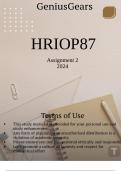HRIOP87
Assignment 2
2024
,QUESTION 1
Nel & Kristen (2020), Chapter 2
Briefly discuss the key ingredients of employment relations dynamics. Use the
following guidelines:
1.1 Introduction Start with a critically discussing the shifting boundaries and
move beyond a strictly tripartite perspective to a multipartite perspective.
Employment relations dynamics have evolved from a traditional tripartite perspective, involving employers,
employees, and the state, to a multipartite perspective that encompasses a broader range of stakeholders
and influences. The shifting boundaries reflect the changing nature of work, organizational structures, and
societal expectations.
1.2 Overview of the role-players and stakeholders in employment relations.
Critically discuss the role-players and stakeholders in employment relations by
referring in your answer to employer parties, employee parties and the State.
Also, identify and explain which parties form part of the “actors”, role-players
and stakeholders in employment relations systems, with particular reference
to South Africa.
Employment relations involve multiple role-players and stakeholders.
Employer parties typically include individual employers, business associations, and management
representatives. They wield power over employment conditions, decision-making processes, and labor
practices within organizations.
Employee parties encompass individual workers, trade unions, and employee representatives. They
advocate for worker rights, negotiate collective agreements, and participate in decision-making processes t
ensure fair treatment and protection of workers' interests.
The State, represented by government agencies, regulatory bodies, and policymakers, plays a crucial role i
shaping employment relations through legislation, enforcement mechanisms, and policy interventions. It
balances the interests of employers and employees while promoting economic growth, social justice, and
labor market stability.
In the context of South Africa, additional actors and stakeholders contribute to employment relations
dynamics. These may include:
●
Trade unions such as COSATU (Congress of South African Trade Unions) and NACTU (National Counc
of Trade Unions), which play a significant role in advocating for workers' rights and influencing labor
policies.
●
Employer organizations like Business Unity South Africa (BUSA) and the Black Business Council (BBC),
which represent the interests of employers and engage in collective bargaining with trade unions.
●
Government departments such as the Department of Employment and Labor, responsible for formulating
labor policies, enforcing labor laws, and promoting decent work standards.
●
Non-governmental organizations (NGOs), civil society groups, and academic institutions, which provide
research, advocacy, and support services to enhance labor rights, social dialogue, and workplace
democracy.
1.3 Conclusion Critically review a real-life scenario in society
(cite the reference) where you see these dynamics at play. (20)
,In contemporary South African society, employment relations dynamics are shaped by a myriad of factors and
stakeholders. A real-life scenario that exemplifies these dynamics is the ongoing debate and activism
surrounding labor market reform and the implementation of the National Minimum Wage Act.
For instance, the South African Federation of Trade Unions (SAFTU) has been vocal in its opposition to the
current minimum wage level, arguing that it is insufficient to meet the basic needs of workers and address incom
inequality. In contrast, employer organizations have raised concerns about the potential impact on business
competitiveness and employment levels. The State, through the Department of Employment and Labor, faces the
challenge of balancing these competing interests while promoting social justice and inclusive economic growth.
This scenario underscores the complexity of employment relations dynamics in South Africa, characterized by
negotiation, conflict, and cooperation among various actors and stakeholders striving to advance their interests
and uphold labor standards in a rapidly changing socio-economic landscape. (Reference: South African
Federation of Trade Unions, Department of Employment and Labor)




